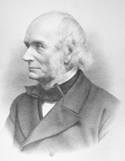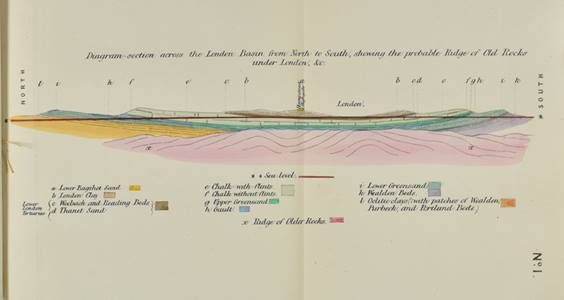Strata under London
 |
| Joseph Prestwich’s "Geological map and sections in illustration of the relative position and areas of the Lower Tertiary and Upper Secondary water-bearing strata around London’" produced to accompany his monograph ‘A geological inquiry respecting the water-bearing strata of the country around London, with reference especially to the water-supply of the metropolis; and including some remarks on springs. London: John van Voorst (1851). GSL Library collection. |
 |
| Joseph Prestwich, FGS, in the 1870s. Archive ref: GSL/POR/56/26 |
Despite this part-time existence, Prestwich’s geological work was highly influential. For instance his work on the Lower Tertiary strata, for which he was awarded the Society’s Wollaston Medal in 1849, laid the foundation for all subsequent research on British Tertiary succession. Prestwich, alongside his close friend John Evans (1823-1908), would also provide proof of the antiquity of man which until then was still entangled in the biblical timeline.
During his work investigating the geology of London, Prestwich had come across the use of artesian wells in the city but was aware of the lack of knowledge concerning their feasibility for use on an industrial scale. As it had become a topic of interest during the various water commissions, and in a bid to promote geology’s application to such practical measures, he turned his attention to ascertaining the potential sources of groundwater supply in the strata below London – in short what we would recognise as a hydrogeological survey of London.
His first paper on the subject was read before a meeting of the Royal Institute of British Architects in July 1850. It was then expanded into the short book ‘A geological inquiry respecting the water-bearing strata of the country around London, with reference especially to the water-supply of the Metropolis; and including some remarks on springs’ (1851). Alongside, Prestwich produced the above geological map which is the first to record hydrogeological information in Britain.
Prestwich agreed with the opinion of Robert Stephenson that the water in the Chalk under London would not be replaced quickly enough by rainfall to meet demand. Indeed he noted that the water level had dropped significantly in the last thirty years. Below this were the Upper and Lower Greensand strata and going by the limited wells which had been sunk into these strata, Prestwich suggested that the water quality was likely to be very good. The Upper Greensand was in theory more accessible but the stratum was relatively thin and therefore the amounts of water it could supply were uncertain. The thicker Lower Greensand was much more promising.
An attempt was made to drill an artesian well into the Lower Greensand at the Crossness Pumping Station in south east London in the late 1860s which was undertaken by the famous sanitary engineer Joseph Bazalgette (1819-1891). Whilst Bazalgette successfully drilled through the Upper Greensand formation and into the Gault he could not reach the elusive Lower Greensand stratum. We now know this is because the Lower Greensand does not extend continuously under London as Prestwich supposed.

